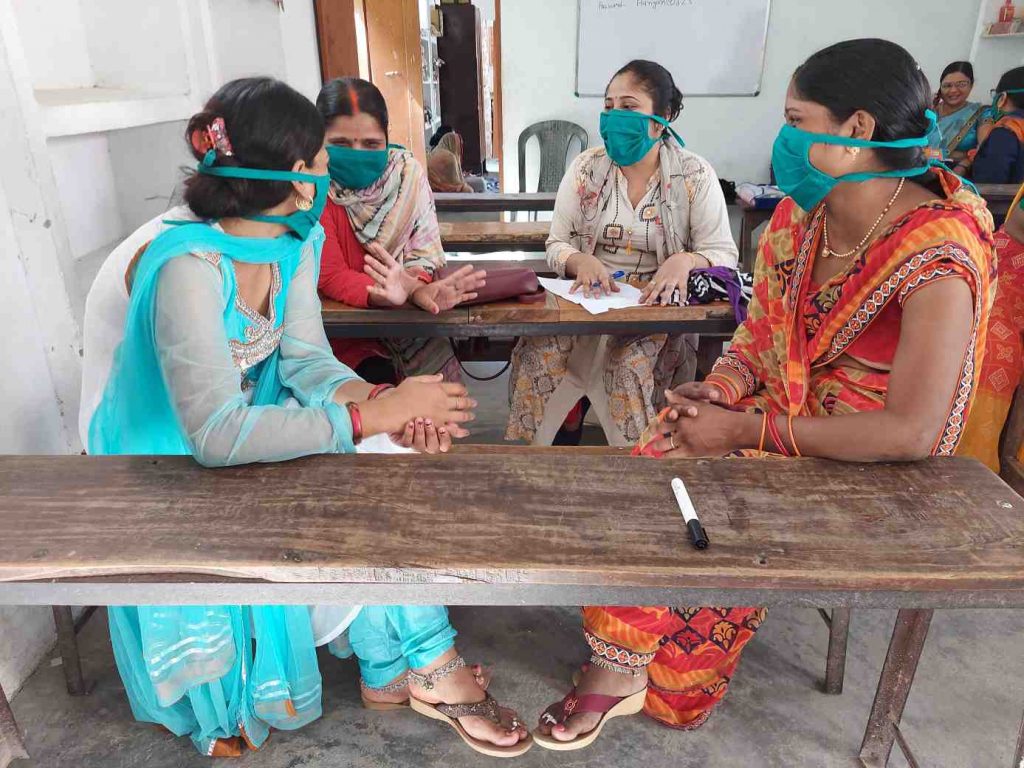Global studies and research provide clear evidence about the long-lasting effects that any disaster or conflict has on socio-economically disadvantaged communities and populations. These include loss of life; loss of livelihoods; homelessness and displacement; extreme violence against women, girls, and the elderly; insufficient support from the state; reduced capacity to respond and adapt; and severe post traumatic stress. All of this further perpetuates marginalisation and poverty.
When COVID-19 hit India last year, we recognised that the little progress we had made in protecting the rights of our children, especially girls, over the last decade, was already being (or would be) destroyed as families began experiencing the effects of the pandemic. Fairly early, almost at the onset of the pandemic, there was an understanding and an acknowledgement of the devastating consequences that this would have on girls from marginalised communities for a long time to come. One such dire consequence is child marriage.
One in three of the world’s child brides lives in India.
It is a well-known fact that even before COVID-19, girls in India were forced into child marriage, with one in three of the world’s child brides living in India. But there has been a surge in child marriage today and the reasons and the data for that is widely documented. For example, according to Childline, there was a 17 percent increase in distress calls linked to early marriage of girls in June and July 2020, compared to 2019. This surge in child marriage is due to the belief that it will salvage the family from financial distress.

More than a year into the pandemic, our government systems continue to be overburdened, schools remain shut, and economic stress seems endless. The crisis of child marriage deserves renewed attention and urgency. But is that enough?
Responding to child marriage can be simplified down to a range of approaches and strategies. But, at Aangan, our experience shows us that the quiet, yet unwavering, leadership that our women child protection volunteers have demonstrated in the midst of this crisis is the common influence across every story, case, or situation. Over the last year, through our women child protection volunteers who have been trained to protect and prevent harm and exploitation to children, we have been able to prevent child marriages in 481 cases across five states.

Through an analysis of the trends and cases where marriages were successfully delayed, we advocate for three key strategies that our child protection volunteers implemented and have worked for us.
1. Build social capital
We believe that the work of preventing harm cannot happen amidst a crisis, particularly when systems—both formal and informal—are falling apart or unresponsive. This belief is core to our approach and therefore a key focus is to facilitate and build a support system with a diverse range of stakeholders around volunteers, all of whom are working towards a common goal.
Social capital that is built on the foundations of support, collaboration, and action is integral in order to prevent child marriage.
The volunteer knows very well that she cannot do this work alone. With this slowly growing safety net of individuals the community then begins to see the role of the volunteers as a partner, a problem solver, and a negotiator who is working not just in the best interest of the child, but the entire family, and in instances, even the community. The families and the community see that the work of the volunteers is not just limited to times of crisis but is constant and ongoing. This strong social capital that is carefully built over time plays a significant role in addressing sensitive issues such as child marriage when they arise. We have observed that:

- A strong safety system ensures that there are more ears and eyes on the ground—they began to work like ‘whisper circles’. In over 93 percent of cases, volunteers received information on preparations for impending marriages taking place through informal and indirect reports by community members. When community members in the ‘whisper circles’ heard rumours about child marriages being planned, these warning signs were communicated to child protection volunteers early, ensuring that action could be taken in a timely way.
- For our volunteers, the phrase, “it takes a village…” is at the crux of their work. But it goes beyond just building the support system. It ensures collective ownership and an understanding of the responsibilities that each stakeholder has towards keeping children safe. In 68 percent of the cases, volunteers worked with other stakeholders in delaying planned marriages. For example, ASHA workers and Anganwadi sevikas were trained on simple ways to detect early warning signs of a marriage being planned. In Bharatpur, Rajasthan, commitments from men were elicited resulting in 167 fathers and 62 brothers saying that they would not push their daughters and sisters into early marriages. In Patna, Bihar, village mukhiyas (village heads) and ward members pressured pandits (priests) and wedding decorators to stop providing their services at weddings involving minors.
The social capital that is built on the foundations of support, collaboration, and action is now integral to the prevention of early marriages and will continue beyond the current crisis.
2. Leverage the power of dialogue and negotiation
Dialogue, conversations, repeated discussions, negotiations—all of the above were key factors in the success of delaying marriages. In 89 percent of the cases, volunteers used dialogue and negotiation as the first step and main strategy in changing the family’s decisions. In seven cases, the girls themselves—who were also trained to have these conversations—were successful in delaying their own or their sibling’s marriage.
While one may argue that this is time-consuming and requires skill, the conversation allows for an understanding of the underlying issues, fears, and structural problems for example financial constraints being faced by the family. And with this knowledge the women volunteers are in a better position to offer alternative solutions and present viable options. Some basic strategies that women volunteers use while negotiating with families are:
- Identifying the main decision maker in the family and negotiating with them directly.
- Spotting an ally within the family who can be cultivated as a supporter.
- Leveraging the support of the most influential member in the community, most often an elderly male member who could help with negotiations. In 30 percent of the cases, women volunteers sought support from credible men in the community who were able to negotiate better with the fathers.
- Although most parents know about laws that prevent child marriage, many do not believe that officials will take it seriously. For instance, in Pakur, Jharkhand, the parents of a young girl were told about a case in an adjacent village where police had intervened and arrested both the parents and the in-laws of the bride. Sharing cases of where legal action has been taken warns parents not to ignore the laws completely.
3. Enhance girls’ own preparedness to self-report
The protection of children is not their responsibility. It is the responsibility of the formal government system and adults in their lives to keep them safe. Having said that, in order to empower girls and build their agency, it is crucial that they have the knowledge, tools, and skills necessary to remain safe.
Through attending monthly sessions on basic laws and rights, ways to identify warning signs of harm, strategies to stay safe, systems and people to access, girls themselves are in a stronger position to seek support in a situation when they are faced with child marriage. The sessions go beyond awareness building. They prepare the girls to respond and act when faced with a difficult situation. For example, in 8 percent of cases, the at-risk girls themselves reported the planning of their marriages to volunteers. Whilst self-reporting is exceedingly difficult for a girl to do, knowing what she can do and whom she can access and reach out to, gives her the voice she most often needs.
No doubt, the above strategies are challenging and even harder to implement in the moment of a crisis. But the stakes are too high for our girls and preventing harm before it occurs is crucial and imperative.
—
Know more
- Learn more about the spike in child marriages during the second wave of the pandemic in India.
- Dip into this collection of resources on the conventions, policies, and laws that regulate child rights.
Do more
- Reach out to the author at contact@aanganindia.org to learn more about Aangan’s work and access training material and tools to activate women’s groups for child protection.


